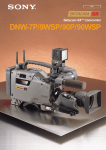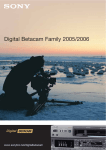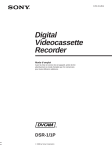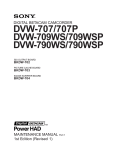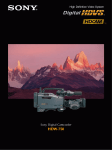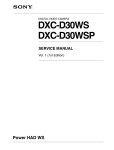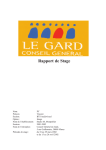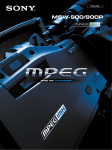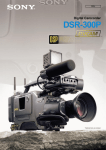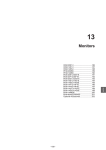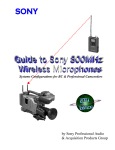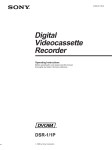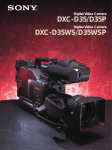Download DVW-790WS DVW-709WS DVW-707 Sony Digital Camcorder
Transcript
NTSC Sony Digital Camcorder DVW-790WS DVW-709WS DVW-707 Preliminary More than just Great Pictures The new 12 Bit A/D Sony Digital Betacam camcorders. They may look familiar, but are loaded are many new features and technologies. These outstanding new camcorders combine extraordinary image quality with remarkable operational flexibility. They deliver more than just great pictures! 2 3 ‘In-Camera’ Creativity A camera is a creative tool and it should allow its user to work smoothly and confidently, with no operational distractions or worries. When designing a camera, the vital first step is to determine the tasks the camera will undertake. Then the optimum balance of form and function that will enable an operator to fulfill these tasks can be established. This synergy is vital because the combination of camera design and operator's skills is paramount to final look of a production. With these objectives in mind, and building on the digital heritage and unrivaled imaging know-how of Sony, we designed the new Digital Betacam camcorders. The result is the second generation of Digital Betacam camcorders –created with the sole purpose of producing perfect pictures. From the very first frame shot for a production, the videographer has the power to make unique creative contributions. Using these models, so much more can now be done ‘In-Camera than ever dreamed of before. The new Digital Betacam camcorders deliver outstanding "in-camera" creativity! 4 5 The Format that means DTV Quality and Performance! The Digital Betacam format uses 10-bit component digital recording to provide superb picture quality and multi-generation capability. Conforming to the ITU-R BT 601 standard adopted for the D-1 format, Digital Betacam records a 4:2:2 digital component video signal together with four channels of 20-bit/48 kHz digital audio. Bit Rate Reduction (BRR) technology has made it possible to provide very efficient handling of video signals. Digital Betacam uses very mild intra-field video compression of about 2:1. Applying compression within each field avoids aliasing, ensuring outstanding multi-generation performance. Because of its robustness, reliability and high-end performance, Digital Betacam has been accepted as the best field acquisition format for the DTV era. Digital Betacam is also an industry standard for the production and post-production of demanding and sophisticated programs. A large number of post-production houses worldwide offer Digital Betacam based editing. Digital Betacam has also become the dominant digital format for program interchange, with a large majority of broadcasters using it as their preferred transmission format. Many industry awards for innovation and technology had been awarded to Sony for the Digital Betacam. Digital Betacam is the format that means quality and offers extra piece of mind to production teams and broadcasting organizations. 1994-1995 Emmy Award for Digital Betacam 6 7 A New Family of Camcorders for a wide range of production Working closely with world-leading cinematographers and program producers, Sony has been honing Digital Cinematography as a valid alternative to film production. During this time, an ever increasing number of high-end commercials, dramas and documentaries have been shot with the widely admired DVW-700WS Digital Betacam Camcorder. Many users’ ideas and recommendations have now been incorporated in the three new camcorders. DVW-790WS The is the direct successor of the DVW-700WS, and the perfect tool for demanding Digital Cinematography applications. It incorporates 2/3-inch (520K) Power HAD FIT CCDs with a 16:9/4:3 switchable aspect ratio. DVW-709WS The is ideal for cost-effective Digital Betacam widescreen shooting. It utilizes proven 2/3-inch (520K) Power HAD IT CCDs with 16:9/4:3 switchable aspect ratio. DVW-707 The provides the opportunity to enjoy the advantages of the Digital Betacam format at a low cost. It employs 2/3-inch (400K) Power HAD IT CCDs with a 4:3 aspect ratio. This wide range of models is perfectly suitable for a wide range of productions. 8 9 We give you the tools. We give you the support. 10 Now go make more great pictures! 11 New Technologies for New Creativity Power HAD™ Technology All new models employ Power HAD CCDs. Building on the Hyper HAD™ system, with the On-Chip-Lens layer that brought major improvements to camera performance, further technological improvements have been incorporated to implement Power HAD technology. Power HAD sensors further reduce vertical smear, allowing total freedom of picture content. They are also more sensitive, enabling production in low light conditions and contributing significantly to outstanding signal to noise ratio performance. The Power HAD sensors in the DVW-707 are rated at F10.0 at 2000 lux (equivalent to 600 ISO or more) while the DVW-709WS and DVW-790WS have a sensitivity of F9.0 at 2000 lux (equivalent to 500 ISO or more). Advanced Digital Signal Processing The new and very sophisticated 12-bit A/D Converter and the Advanced Digital Signal Processing (ADSP) used by the new Digital Betacam camcorders ensure not only superb picture quality with a wide dynamic range (600%) and enhanced tonal reproduction, but also offers enhanced operational features when setting camera parameters. These camcorders have an improved, menu-driven set up that allows a very high level of user customization. This is further enhanced with the use of BSC-1 ‘Smart’ Setup Cards that include an IC-based memory. These cards store preferred settings for the camcorder, making it possible to recreate a desired ‘look’ instantly and effortlessly. Design All three models look identical and have a very similar appearance to their predecessors the DVW-700 and DVW-700WS -although with some subtle but important refinements. When using these camcorders in any production situation, from ENG to Digital Cinematography, the very stylish and ergonomically designed body is quickly appreciated. Thanks to its excellent balance, it sits comfortably on the shoulder and can be firmly attached to a gear-head or tripod for more elaborate shots. Its low optical axis is also helpful. Operating weight, including a viewfinder, battery, cassette, microphone and typical portable lens, is only 7 kg (7-lb. 7 oz). 13 Cassette Loading Vertical cassette loading minimizes the risk of exposure of the tape mechanism to the elements. The robust cassette compartment is dust and drip proof, and minimizes acoustic noise. Stereo Audio Line Output A stereo audio line output is available from the 5-pin XLR connector on the rear of the camcorder. This provides two analog audio output channels, which can be selected to be either CH-1/2 or CH-3/4. Internal Light System All new Digital Betacam camcorder models incorporate an internal light power supply system. An Anton Bauer standard 2-pin socket can supply up to 50 W from the camcorder’s lithium-ion battery. The light can be switched on and off manually or, in Auto mode, is switched on at record start and off when recording stops to maximize battery life. A switch on the side of the camcorders selects Manual or Auto mode. *Anton/Beuer products may not be available in some countries. Optical Filter Wheels Two independent optical filter wheels, one with Neutral Density (ND) and one with Color Correction (CC) filters are installed in both of the widescreen models. An optional servo filter drive unit, the BKDW-701 can also be integrated. The DVW-707 has only one filter wheel, with a combination of ND and CC filters. Electronic Shutter Like the DVW-700 and DVW-700WS camcorders, all three new models have an electronic shutter with the following speeds: 1/60, 1/100, 1/125, 1/250, 1/500, 1/1000 and 1/2000 of a second. This helps capture clear images of fast-moving objects with minimum motion blur. Thanks to the high sensitivity of these camcorders, even the fastest speeds can usually be used with available light. 14 Turbo Gain – High Sensitivity Although nominal sensitivity of all models is high, in some situations it is necessary to shoot in extremely low light. The Turbo Gain feature raises the gain level to an incredible +48 dB. Thanks to this feature, it is possible to record critical scenes down to around 0.2 lux –exceeding the color sight capability of the human eye. LCD Status Panel and Diagnostic System All the main operational switches are in their familiar place on the side of the camera. The LCD panel is on the same side, showing a wide range of status and diagnostic displays. The VTR set-up menu is now displayed in the viewfinder. Clear Scan The Clear Scan function is available to minimize the horizontal bars that can appear when shooting computer CRT displays. The DVW-790WS FIT Camcorder provides Extended Clear Scan, which allows electronic shutter, speeds to be set below 50 Hz. Super EVS Super Enhanced Vertical Definition (EVS) mode increases the vertical resolution of the shot. Frame mode also increases the vertical resolution but is only suitable for shooting still pictures. Shot Data Recording All models have the capability to record many types of relevant production information such as date and time of shooting, shot ID, cassette number and shot number, identifying them for the later stages of production and post production. ASSIGNABLE (assigning function) Button You can assign ATW, RET, REC, Turbo Gain and other functions to this switch. 15 Creative Features for Creative Expressions Menu-driven setup has been a powerful feature of the DVW-700 and DVW-700WS for many years. Setting up a Digital Betacam camcorder has become a creative process instead of a tedious and laborious engineering necessity. Camera operators were given a unique opportunity to customize their camera settings, so that they precisely suited production requirements. Combined with the ability to store data on a ‘smart’ Setup Card, this feature brought a tremendous increase in the operational flexibility of these camcorders. Building on this feature, these new models incorporate even more BSC-1 user-friendly menus and ways of changing parameter values. Featured are five new pages, which can be customized, called ‘Camera Operator Menus’. These allow any single item from any other page to be grouped to make up a custom user’s menu system, which can then be stored on a Setup Card. There are also several new and exciting operational capabilities; the most important of which are now described in relation to the most significant picture parameters. Rotary Menu Switch Colorimetry The DVW-790WS, DVW-709WS and DVW-707 produce pictures with astonishing color reproduction accuracy, yet offer ultimate creative freedom. Multi Matrix This function allows a particular color to be automatically selected, and its hue and saturation altered within a range of approximately 20 degrees. This permits one set color correction, helping to minimize expensive color correction during post-production. Normal After Color Balance Color balance is widely regarded as one of the essential settings for any shoot. There are a number of alternative ways of setting this when shooting with Digital Betacam camcorders. By using Auto White (and Black) balance, an accurate overall color balance can be obtained. Alternatively, using the remotely controllable paint functions, color levels can be adjusted according to the operator’s needs. For this operation, either the new RM-B150 or the existing RM-P9 Remote Control Units can be used. When the desired color balance has been achieved, the remote control unit can be disconnected without disturbing the settings. RM-B150 Auto Tracing White Balance The DVW-790WS, DVW-709WS and DVW-707 all include Auto Tracing White (ATW) balance. This allows automatic tracing of white balance in situations where the overall colorimetry of the lighting changes. This is a particularly useful feature for continuous shooting that requires the subject to be followed from exterior to interior, i.e. from daylight to tungsten lighting, with no opportunity to readjust the white balance manually. ATW switch Color Temperature Control It is now possible to “dial in” the required color temperature of the camera. The overall color balance of the picture can be changed to make it ‘warmer’ or ‘colder’. This feature can be used very creatively, particularly in scenes with mixed color lighting. Normal Warmer Colder 17 Contrast Range The new DVW-790WS, DVW-709WS and DVW-707 can handle a very impressive contrast range. A number of useful features are readily available to help production crews meet specific shooting requirements. Gamma The gamma curve, in general, determines the way in which mid-tones are handled and therefore is of vital importance in achieving the overall ‘look’ of a shot. Changing master gamma is achieved either from a remote control unit or via the setup menu. These new camcorders are provided with a more natural and smoother gamma curve with 48 gamma points (the previous generation of DVW-700 and DVW-700WS models had 32 gamma points) and therefore a more natural overall tonal reproduction. In addition to master gamma and gamma balance, several independent gamma curves are provided to increase operational flexibility. They can all be accessed via the setup menu. Curve A is the standard setting. Curve B gives a higher initial gamma gain, stretching black areas of the picture. Gamma C further increases the initial gamma. Gamma F is the so-called ‘Film Gamma’ and represents the average transfer characteristics of a few of the most popular film stocks. It has a shallow slope in the shadow area, slopes uniformly in the mid-tone region and flattens off in the highlights, enhancing the overall dynamic range. All of the above gamma curves are factory standard. However, the Gamma S position is reserved for a gamma curve that can be read from the Digital Gamma Setup Cards (BSC-1F1 Pack) or from a PC running Sony BZP-100 setup software. This software allows this gamma curve to be modified. Gamma A Normal Gamma F Black Gamma The Black Gamma function helps to control shadow areas with precision. It can help to bring out details from the dark areas of the picture without affecting mid-tones and keeping the absolute black level unchanged. The range of creative possibilities offered by the flexibility of setting up Gamma and Black Gamma is inspiring and offers users a great advantage in achieving a desired ‘look’. 18 Highlight Handling Thanks to Power HAD technology and Advanced Digital Signal Processing, Digital Betacam camcorders cover a very wide dynamic range of up to 600%. Dynamic range is often defined as the capability of a camera to capture a very large difference between the brightest and darkest parts of a scene, and is very dependent on the knee circuits. A well-known problem with using auto knee is the effect on skin tones. To overcome this problem, and improve overall picture quality, the new Digital Betacam camcorders incorporate TruEye™ processing. Like the human eye, this processes the dynamic range of the camera before gamma correction by using brightness, hue and saturation instead of individual red, green and blue signal processing. Knee correction is therefore effectively processed only on the brightness (luminance) signal content. As far as saturation is concerned, the video level of each of the red, green and blue channels can be compressed without causing hue rotation, although the saturation slowly decreases as the signal level approaches clipping. The correct hue is maintained, and an image can naturally converge into white at the clip point. Because the net result is faithful color reproduction above the knee point, the knee point can be lowered from the conventional value of 98% to 85%, and also the knee slope is much larger. This gives a much wider visible dynamic range. How TruEye Processing Functions To understand the knee circuits used in the new camcorders, it is necessary to understand TruEye Processing. TruEye processing is one of the most innovative features that DSP allows, and makes it possible to reproduce more natural colors than a conventional analog camera, even in severe shooting conditions. The knee circuit is necessary to compress the very wide dynamic range of the CCD sensor (600%) to the much more limited recording standard (109%). The knee circuit function is to compress the video output level when it exceeds a pre-determined video input level, called the knee point. Thus, the dynamic range of the camera can be broadened, and images in bright areas that exceed the standard video level can be seen. In conventional analog cameras, knee correction is performed individually on the red, green and blue channels. Since the knee correction is a non-linear process, and is located after gamma correction, the balance of hue, saturation and brightness are changed after processing. The point at which the knee circuit of each color operates will depend entirely on the picture composition and color balance. Therefore, one color may be in the non-linear part of the transfer curve (above the knee point) while another is still quite linear (below the knee point). In this case, the hue is rotated in bright parts of the picture, and faithful color reproduction is impossible. This is why human skin tends to look yellow when parts of the picture are even slightly overexposed. In a normal situation where the overall exposure is correct, some areas in the picture tend to be more reflective than others – a shiny forehead is a typical example. Knee Saturation Knee saturation acts in concert with TruEye to maintain saturation in picture areas compressed by the knee function. Normally any highlight, which is above the knee threshold, will reduce the saturation to the white clip point. Picture area above the white clip level will be reproduced as white. RGB Knee Conpensation Advanced TruEye Conventional TruEye 19 Definition – Picture Sharpness The new Digital Betacam camcorders reproduce pictures with natural sharpness and fine details. The new 12-bit ADSP, together with many new and innovative detail functions, allows very precise control of the way picture texture and edges are represented. This is an important factor when using post-production techniques such as multi-layering and chroma keying. Soft Focus This new feature allows the picture to be softened in a similar manner to using optical filters. The Soft Focus control is particularly convenient for those who find traditional images to be to sharp. This fine adjustment allows the creation of more cinematic or film-like pictures. Normal Soft Focus Adaptive Detail The Adaptive Detail control, also known as Knee Aperture, ensures that the detail enhancement in the highlight areas looks natural. By automatically reducing the amplitude of the detail enhancement signal in the highlight area, detail aliasing in these areas is completely eliminated. Skin-Tone Detail Correction Skin Tone Detail Correction controls the detail level of specific color tones within the image. It is particularly useful when talent with minor skin blemishes. With this function only selected areas of the picture are affected while the remainder of the scene maintains its full crispness. Furthermore, detail within selected areas can be enhanced as well as softened. Picture Stability Digital Betacam camcorders deliver rock steady pictures. There is none of the picture weave usually associated with material originated on film. The picture stability is particularly relevant for productions incorporating multi-layering effects. The emergence of highly compressed delivery systems, including DVD and digital transmission using multiple groups of pictures (GOP’s) demands a high level of picture stability to maintain picture quality – especially when highly compressed within an MPEG-based environment. Texture Because of their very good signal to noise ratio performance, the DVW-790WS, DVW-709WS and DVW-707 deliver grain-free pictures with almost transparent texture. This is particularly useful when working on productions that require multi-layering and blue-screen effects. 20 21 Operational Accessories A full range of operational accessories is available to take full advantage of the versatility and operational features of these new camcorders. Picture Cache Board (Optional) The BKDW-703 Picture Cache Board option is available for all three models. This unit provides up to eight seconds of loop recording using solid state memory. Thus, when the REC start button is pressed, everything that happened up to eight seconds before that moment is recorded on tape. If something happens in front of your camera, you will still have up to eight seconds to decide whether or not you want it recorded to tape. You have the choice of recording for 1, 2, 4 or 8 seconds. SDI Output Board (Optional) To increase the operational convenience of all Digital Betacam camcorders, the new optional BKDW-702 SDI Output Board is available. When installed into any of the three models it provides an SDI output signal, as defined by ITU-R BT601, from the rear Video Output connector. This way production crew on location can have ready access to the SDI output without an adapter. Digital Cinematography Accessories (Optional) Recognizing the acceptance of Sony Digital Betacam camcorders for Digital Cinematography use, many manufacturers are offering film-style accessories for the DVW models. These include special digital cinematography zoom and prime lenses, base plates, matte boxes, follow focus units, etc. This is particularly helpful for crews principally used to working with film. A range of special lenses optimized for Digital Cinematography production are available from most manufacturers. These are mainly calibrated in T-stops rather than F-stops, have more focus resolution, Arri gear teeth for follow focus kits and a reduced zoom range. There is also a range of prime lenses for 2/3-inch mount cameras. Extended Viewfinder (Order-based) The new Sony extended viewfinder, the BKW-LVF1, is of particular interest to crews used to film-style shooting. The extension viewfinder enhances the operation of the Digital Betacam camcorder when mounted on gear heads. Color Viewfinder (Optional) Film professionals who are used to seeing color viewfinder image welcome the BVF-VC10W Color Viewfinder. It offers accurate colorimetry – even in bright sunlight. 23 Digital Cinematography style of shoot Any of the three new Digital Betacam camcorders will undoubtedly produce some of the finest and most accurate pictures even when using the standard settings. To achieve a more cinematic or film-like look, special attention has to be paid to camera settings and the use of appropriate operational accessories and lenses. The flexibility of these camcorders, together with cinematic-style shooting, lighting and techniques will provide very gratifying results. With Digital Cinematography, high production value is ensured through exceptional picture quality. High production confidence is 24 guaranteed through immediacy and instant review of the material right on location. Increased production efficiency is facilitated through direct to digital production, eliminating the Telecine transfer before beginning post-production. Also savings are realized through the use of only one inexpensive recording media. Digital Cinematography has widely been accepted as an economic, high quality alternative for program production. Shooting on Digital Betacam tape also means more control in post-production. There are no costs for processing and telecine transfer. Different camera ting settings can be saved on memory cards for different kinds of looks and can be recalled in seconds. The creative possibilities harnessed by the manipulation of parameters such as colorimetry, detail correction, skin-tone detail correction, gamma and highlight control etc., allow the camera’s performance to be optimized for each take. Sony’s Digital Cinematography fully satisfies production needs. The technology has evolved to offer a versatile and efficient production system even for the most demanding programs. 25 The Assurance of Sony This is the start of a great relationship. With every new Digital Betacam, you get far more than just a camera. At Sony we aim to serve you promptly and professionally, and we hope to become a valuable partner to your business. We give you access to a range of services and benefits designed to make ownership as enjoyable, affordable and trouble-free as possible. And if you ever need assistance, we put our existing worldwide network of over 400 service outlets at your disposal. You know you can rest assured with Sony. 26 27 Optional Accessories Sony CA-701, Camcorder Adapter Sony CA-702, Camcorder Adapter Sony CA-755, Camcorder Adapter Sony BVF-V10, 1.5-inch B/W Viewfinder Sony BVF-V20W, 2-inch Widescreen B/W Viewfinder Sony Viewfinder Eye-piece, A-8314-798-A (High performance, x3) Sony Viewfinder Eye-piece Sony BSC-1 Pack, Setup Card Sony AC-DN1, AC Adapter Sony AC-DN2A, AC Adapter Sony BP-L60A/L90A, Lithium-ion Battery Sony BC-L100, Battery Charger Sony BC-L50, Battery Charger Sony WRR-855A, Wireless Microphone Receiver (Adapter required) Sony BKDW-701, Servo Filter Unit Sony BKDW-704, Image Inverter Board (For DVW-709WS/790WS) Sony BKW-401, Viewfinder Rotation Bracket Sony VCT-14, Tripod Adapter Sony CCU-550A, Camera Control Unit (For CA-755) Sony BVF-55, 5-inch B/W Viewfinder (For CA-701/702/755) ARRI EL-3, Eyepiece Leveller (to support BKW-LVF1) 28 A-8262-537-A(High magnification) A-8262-538-A(Low magnification) A-8267-737-A(Standard magnification with special compensation for aberrations) Sony CAC-6, Return Video Selector (For CA-755) Sony PVM-8045QD, Colour Video Monitor (With optional DC-L10) Canon EJ6, Prime lens Canon EJ10, Prime lens Canon EJ15, Prime lens Canon EJ24, Prime lens Canon EJ35, Prime lens Canon J9a x 5.2B KLL-SC, Digital Cinematography zoom lens MB-300, Matte Box (for J9a x 5.2B KLL-SC) Fujinon A10 x 4.8B-10, Digital Cinematography zoom lens Angenieux 5.3 - 61 mm HR, Digital Cinematography zoom lens OpTex /Canon 8-160 mm EC Zoom Lens (Digital Cinematography zoom lens) Angenieux 12 x 5.3 AIF HR, ENG zoom lens Fujinon A19 x 8.7 RM, ENG zoom lens Canon J21a x 7.8B IRS, ENG zoom lens ARRI Geared head ARRI SAP-1, Sony Adapter Plate ARRI MB-17, 4" Matte Box (set) ARRI FF-4, Follow Focus (set) ARRI BP-6, Bridge Plate (with 15mm bars) *A certain model may not be available in some countries.For the details,please contact each manufacturer. 29 System Configuration BVF-55 CCU-700A MSU System TRIAX Anton/Bauer UI2 (option) WRR-860A(Adapter reguired) (option) VCS-700 CA-755 CCU-550A CAC-6 BSC -1 BKW-401 (option) MSU-700 RCP-700 Series XLR 4-pin BSC-1 AC-550 Monitor,etc BKW-LVF1 (Made-to-order) SDI CA-701 DVW-250 26p BKDW-703 (option) BKDW-702 (option) BKDW-701 (option) CA-702 Viewfinders BVF-VC10W 1.35-inch 16:9 Color Viewfinder BVF-V10/V10CE 1.5-inch 4:3 B/W Viewfinder (supplied with DVW-707) BVF-V20W/V20WCE 2-inch 16:9 B/W Viewfinder(supplied with DVW-709WS/790WS) VCT-14 Battery Chargers BP-L60A/L90A BC-L50/L50CE (BP-L60A/L90A NP-1B/BP-90A in DC-L1/L90) AC-DN1+DK-2401/2401L BC-L100/L100CE (BP-L60A/L90A NP-1B/BP-90A in DC-L1/L90) BC-410/410CE (for NP-1B or BP-90A) AC-DN2A DC-L1 NP-1B DC-L90 BP-90A BC-1WD/1WDCE (for NP-1B) 8-pin RM-B150 Video Cassettes BNC Monitor LC-777 Carrying Case 30 BCT-D6/D12/D22/D32/D40 BCT-D12CL Specifications Model Name DVW-707 DVW-790WS DVW-709WS 16:9 MODE 4:3 MODE 16:9 MODE 4:3 MODE General Mass Operating weight Power requirements Power consumption Operatingtemperature Storage temperature Humidity Continuous operating time Signal inputs Genlock video Time code input Audio (CH-1/2) Mic input Signal outputs Video output Video test output Time code output Earphone Audio output(CH-1/2) Others Lens Remote Light DC input DC output Camcorder adapter Approx. 5 kg (11 lb. 1 oz) Approx. 7 kg (15 lb. 7 oz) DC 12 V +5.0 V / -1.0 V 29 W 0 °C to +40 °C (+32 °F to +104 °F) -20 °C to +60 °C (-4 °F to + 140 °F) 25 % to 85 % (relative humidity) Approx. 5 kg (11 lb. 1 oz) Approx. 7 kg (15 lb. 7 oz) DC 12 V +5.0 V / -1.0 V 31.5 W 0 °C to +40 °C (+32 °F to +104 °F) -20 °C to +60 °C (-4 °F to + 140 °F) 25 % to 85 % (relative humidity) Approx. 5 kg (11 lb. 1 oz) Approx. 7 kg (15 lb. 7 oz) DC 12 V +5.0 V / -1.0 V 32 W 0 °C to +40 °C (+32 °F to +104 °F) -20 °C to +60 °C (-4 °F to + 140 °F) 25 % to 85 % (relative humidity) Approx.135 min.(With BP-L60A) Approx.205 min.(With BP-L90A) Approx.125 min.(With BP-L60A) Approx.190 min.(With BP-L90A) Approx.120 min.(With BP-L60A) Approx.185 min.(With BP-L90A) BNC type (x1), 1.0 Vp-p, 75 Ω BNC type (x1), 0.5 to 18 Vp-p, 10 kΩ XLR-3-31 type (x2), -60 dBm / +4 dBm selectable, high impedance, balanced XLR-3-31 type (x2), -60 dBm / +4 dBm selectable, high impedance, balanced BNC type (x1), 1.0 Vp-p, 75 Ω BNC type (x1), 0.5 to 18 Vp-p, 10 kΩ XLR-3-31 type (x2), -60 dBm / +4 dBm selectable, high impedance, balanced XLR-3-31 type (x2), -60 dBm / +4 dBm selectable, high impedance, balanced BNC type (x1), 1.0 Vp-p, 75 Ω BNC type (x1), 0.5 to 18 Vp-p, 10 kΩ XLR-3-31 type (x2), -60 dBm / +4 dBm selectable, high impedance, balanced XLR-3-31 type (x2), -60 dBm / +4 dBm selectable, high impedance, balanced BNC type (x1), 1.0 Vp-p, 75 Ω BNC type (x1), 1.0 Vp-p, 75 Ω BNC type (x1), 1.0 Vp-p, 75 Ω Minijack XLR-5-pin male (stereo) BNC type (x1), 1.0 Vp-p, 75 Ω BNC type (x1), 1.0 Vp-p, 75 Ω BNC type (x1), 1.0 Vp-p, 75 Ω Minijack XLR-5-pin male (stereo) BNC type (x1), 1.0 Vp-p, 75 Ω BNC type (x1), 1.0 Vp-p, 75 Ω BNC type (x1), 1.0 Vp-p, 75 Ω Minijack XLR-5-pin male (stereo) 12-pin 8-pin 2-pin, DC 12 V, max. 50 W XLR-4-pin (for the optional AC-550) 4-pin (for wireless microphone receiver), DC 12 V 40-pin 12-pin 8-pin 2-pin, DC 12 V, max. 50 W XLR-4-pin (for the optional AC-550) 4-pin (for wireless microphone receiver), DC 12 V 40-pin 12-pin 8-pin 2-pin, DC 12 V, max. 50 W XLR-4-pin (for the optional AC-550) 4-pin (for wireless microphone receiver), DC 12 V 40-pin Digital Betacam 96.7 mm/s Max. 40 min. with BCT-D40 cassette Less than 6 min. with BCT-D40 cassette Less than 5 min. with BCT-D40 cassette Sony Digital Betacam S cassette, BCT-D6/D12/D22/D32/D40 Series Y: 13.5 MHz, R-Y/B-Y: 6.75 MHz 10 bits / sample Reed-Solomon code Adaptive three dimensional Digital Betacam 96.7 mm/s Max. 40 min. with BCT-D40 cassette Less than 6 min. with BCT-D40 cassette Less than 5 min. with BCT-D40 cassette Sony Digital Betacam S cassette, BCT-D6/D12/D22/D32/D40 Series Y: 13.5 MHz, R-Y/B-Y: 6.75 MHz 10 bits / sample Reed-Solomon code Adaptive three dimensional Digital Betacam 96.7 mm/s Max. 40 min. with BCT-D40 cassette Less than 6 min. with BCT-D40 cassette Less than 5 min. with BCT-D40 cassette Sony Digital Betacam S cassette, BCT-D6/D12/D22/D32/D40 Series Y: 13.5 MHz, R-Y/B-Y: 6.75 MHz 10 bits / sample Reed-Solomon code Adaptive three dimensional Y: 5.75 MHz +/-0.5 dB, R-Y/B-Y: 2.75 MHz +/-0.5 dB More than 62 dB Less than 1 % Less than 2 % Less than 15 ns Y: 5.75 MHz +/-0.5 dB, R-Y/B-Y: 2.75 MHz +/-0.5 dB More than 62 dB Less than 1 % Less than 2 % Less than 15 ns 48 kHz (synchronised with video) 20 bits / sample 16 bits / sample 20 Hz to 20 kHz, +0.5 dB/-0.8 dB More than 85 dB (emphasis ON) Less than 0.08 % Less than –70 dB Below measurable limit 20 dB (ex-factory setting) T1 = 50 µs, T2 = 15 µs 48 kHz (synchronised with video) 20 bits / sample 16 bits / sample 20 Hz to 20 kHz, +0.5 dB/-0.8 dB More than 85 dB (emphasis ON) Less than 0.08 % Less than –70 dB Below measurable limit 20 dB (ex-factory setting) T1 = 50 µs, T2 = 15 µs 100 Hz to 12 kHz, +/-3 dB More than 50 dB, at 3 % distortion level Less than 1.5 % (T.H.D at 1 kHz, reference level) Less than 0.2 % 100 Hz to 12 kHz, +/-3 dB More than 50 dB, at 3 % distortion level Less than 1.5 % (T.H.D at 1 kHz, reference level) Less than 0.2 % VTR section General Recording format Tape speed Playback/Recording time Fast forward time Rewind time Recommended tape Sampling frequency Quantization Error correction Error concealment Digital vidio performance Band width Y: 5.75 MHz +/-0.5 dB, R-Y/B-Y: 2.75 MHz +/-0.5 dB S/N ratio More than 62 dB K-factor (2T pulse) Less than 1 % Linearity Less than 2 % Y/R-Y/B-Y delay Less than 15 ns Digital audio performance Sampling frequency 48 kHz (synchronised with video) Quantization 20 bits / sample A/D and D/A quantization 16 bits / sample Frequency response 20 Hz to 20 kHz, +0.5 dB/-0.8 dB Dynamic range More than 85 dB (emphasis ON) Distortion(at 1 kHz, emphasis ON, reference level) Less than 0.08 % Cross talk(at 1 kHz, reference level) Less than –70 dB Wow & flutter Below measurable limit Head room 20 dB (ex-factory setting) Emphasis(ON/OFF selectable) T1 = 50 µs, T2 = 15 µs AnaIogue audio performance (Cue track) Frequency response 100 Hz to 12 kHz, +/-3 dB S/N ratio More than 50 dB, at 3 % distortion level Distortion Less than 1.5 % (T.H.D at 1 kHz, reference level) Wow& flutter Less than 0.2 % Camera section Camera Pickup device Picture elements Optical system Built-in filters Shutter speed Lens mount Sensitivity(2000 lx, 89.9 % reflectance) Minimum illumination Smear level S/N ratio Vertical resolution Registration Geometric distortion Warm-up time Modulation depth at 5 MHz Viewfinder CRT Controls Horizontal resolution Microphone Supplied Accessories 3-chip 2/3-inch Power HAD IT CCD 3-chip 2/3-inch 16:9/4:3 Widescreen Power HAD IT CCD 3-chip 2/3-inch 16:9/4:3 Widescreen Power HAD FIT CCD 1038 (H) x 504 (V) 1038 (H) x 504 (V) 811 (H) x 508 (V) F 1.4 prism system F 1.4 prism system F 1.4 prism system 1: Clear 2: 5600 K +1/8 ND 3: 5600K 4 5600 K+1/64 ND 1: Clear 2: 1/4 ND 3: 1/16 ND 4: 1/64 ND A: Cross B: 3200 K C: 4300 K D: 6300 K 1/100, 1/125, 1/250, 1/500, 1/1000, 1/2000 (s) 1/100, 1/125, 1/250, 1/500, 1/1000, 1/2000 (s) 1/100, 1/125, 1/250, 1/500, 1/1000, 1/2000 (s) Special bayonet mount Special bayonet mount Special bayonet mount F10.0 (Typical) Equivalent to ISO 600 or more F9.0 (Typical) Equivalent to ISO 500 or more Approx. 0.15 lx(F1.4 lens, +48 dB Turbo Gain) Approx. 0.2 lx (F1.4 lens, +48 dB Turbo Gain) -120 dB -140 dB -125 dB 65 dB (typical) 65 dB (typical) 65 dB (typical) (Without Super EVS) 400 TV lines, (With Super EVS) 450 TV lines (Without EVS) 400 TV lines, (With EVS) 450 TV lines 0.05 % (All zones, without lens) 0.05 % (All zones, without lens) 0.05 % (All zones, without lens) Below measurable level (Without lens) Below measurable level (Without lens) Below measurable level (Without lens) 2 sec. 2 sec. 2 sec. More than 55 % More than 65 % More than 55 % More than 65 % More than 55 % 1.5-inch monochrome BRIGHT control, CONTRAST control, PEAKING control, TALLY, ZEBRA, DISPLAY switches 600 TV lines Ultra-directional (Detachable) Maintenance Manual (x1), Operation Manual (x1), Lens cap (x1), Shoulder belt (x1),Microphone (x1), XLR cap (x4) 2.0-inch monochrome BRIGHT control, CONTRAST control, PEAKING control, TALLY, ZEBRA, DISPLAY switches 450 TV lines (16:9) Ultra-directional (Detachable) Maintenance Manual (x1), Operation Manual (x1), Lens cap (x1), Shoulder belt (x1),Microphone (x1), XLR cap (x4) BRIGHT control, CONTRAST control, PEAKING control, TALLY, ZEBRA, DISPLAY switches Ultra-directional (Detachable) Maintenance Manual (x1), Operation Manual (x1), Lens cap (x1), Shoulder belt (x1),Microphone (x1), XLR cap (x4) 31 © 1999 Sony Corporation. All rights reserved. Reproduction in whole or in part without the written permission of Sony is prohibited. Features and specifications subject to change without notice. All non-metric weights and measures are approximate. Sony is a registered trademark of Sony Corporation. Digital Betacam, TruEye, and Power HAD are trademarks of Sony Corporation. All other trademarks are the property of their respective owners. Distributed by MK7232V1SMC99MAR Printed in Japan
































